The Landing of the Mars Science
laboratory (Curiosity) August 5-6, 2012
The Mars Science Laboratory was the occasion
for as much anticipation as any space mission. It's destination,
Gale crater, was the product of much soul searching and sifting
of the relative merits of several places. The choice assures a
maximum return of insights into the history of Mars, and a great
variety of landscapes in the journey of this most sophisticated
extension of our senses ever delivered to another world. Planetfest
was timed to coincide with the landing of MSL, named 'Curiosity'
as the result of a national student contest.

The Planetary Society brought space and science people together
over that weekend at the Pasadena Convention Center. I was part
of the Saturday August 4 Planetfest panel discussion 'Why
create space art? With Jon Ramer, myself, Rick Sternbach,
Don Dixon and Aldo Spadoni. We each were given a few minutes to
talk, then each answered questions. I said a few things I wanted
to get out there and started to say something that was never finished,
'Mars Hill' being first a space artists gathering place, than
its name being formalized, and finally its use as Mars landing
sets for two nearly identical science TV show productions. The
most important thing I felt like saying was along these lines,
People have asked me if the Hubble images and various space probe
images are the death of space art, if they make space artists
irrelevant. Not at all, they are inspirations for many more works
of art inspired by what we are learning about the Universe around
us. If nothing else, the visual information available for reference
for many amazing celestial object gives us several revalatory
visions where we formally had one. There's always some threshold
we wish we could see more of than any real image can show, always
a place where an artist can carry on the idea of what its like
to be there.
The others spoke of their recollections of
some early visual influences, and something of their own lives
and their operating philosophies. Rick recalled the origin of
the International Association of Astronomical
Artists, the major group of space artists, at an Orange Julious
during the 1981 Planetfest. I then mentioned the 1983 Death Valley
workshop, and Death Valley's 'Mars Hill',
the rubble strewn rise that superficially resembles the Viking
2 landing site. Every one of us did well speaking in front of
a crowd. The horrible part is the waiting to come on, but so long
as you stay on what you know and love you will do fine.
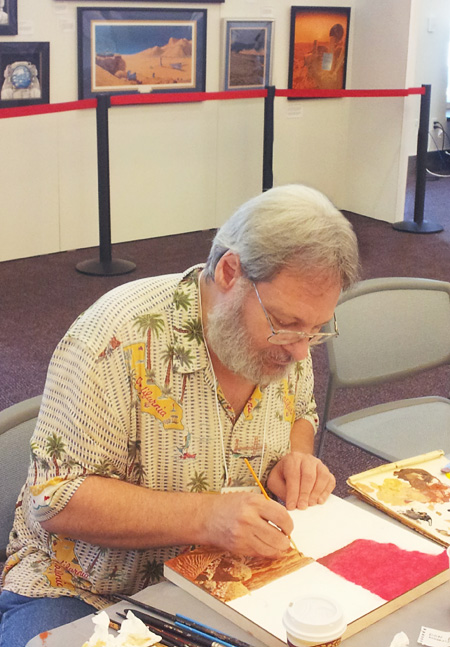
I had a couple Mars oil paintings that had
been damaged in the Northridge Quake that I finally to decided
to retouch, cleaning them and bringing my old oil paint tubes
and related solvents, treating visitors to the sight of someone
painting in traditional media.
It turned out to be the start of something
of a revival of my doing oil paintings, pogressing from retouching
damaged old works. Three times I was asked about a book I recommended
for artists, the old Dover editions of 'The Nature of Light and
Color in the Open Air' by M. Minnaert. A highlight was a little
girl brought to me by her mom, she asked me if the two stars at
the top of the Tim Mutch Memorial Station painting, the original
which was shown there, were the Earth and Moon, which they were!
I congratulated her on her being so observant.
I am finishing up my quadrant of the quickie Mars painting
which was outlied broadly by Jon Ramer, who started the sky on
his section earlier. I painted in both oils and acrylics while
at Planetfest. Photo by Jon Ramer.
Above me to the right can be seen the original oil painting I
did of the Viking 1 lander. The new plaque shown on the dusty
old lander is now at the National Air and Space Museum, awaiting
a mission to place it there. (below right, seen in a digitally
updated color version)
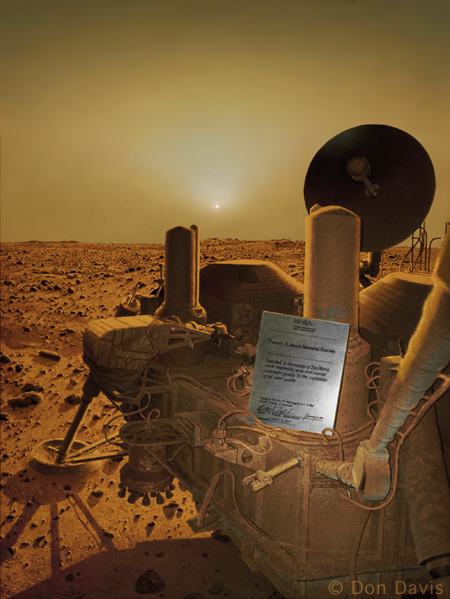
 Later
Saturday Afternoon I went to JPL to get my badge, once in I visited
the courtyard and auditorium, taking many photos of the models
on display for future reference. There was hardly anyone there,
and the interior of Von Karman Auditorium was lit fairly brightly.
The now venerable Voyager spacecraft mockup was along the North
wall as always, with a little exhibit about the record nearby.
Other spacecraft were there, Mars Odyssey and a reduced model
of the Cassini Saturn Orbiter and the Huygens Titan probe. The
models were lit more subdued than before, with colored gel filtered
lights illuminating them giving an almost festive ambiance.
Later
Saturday Afternoon I went to JPL to get my badge, once in I visited
the courtyard and auditorium, taking many photos of the models
on display for future reference. There was hardly anyone there,
and the interior of Von Karman Auditorium was lit fairly brightly.
The now venerable Voyager spacecraft mockup was along the North
wall as always, with a little exhibit about the record nearby.
Other spacecraft were there, Mars Odyssey and a reduced model
of the Cassini Saturn Orbiter and the Huygens Titan probe. The
models were lit more subdued than before, with colored gel filtered
lights illuminating them giving an almost festive ambiance.
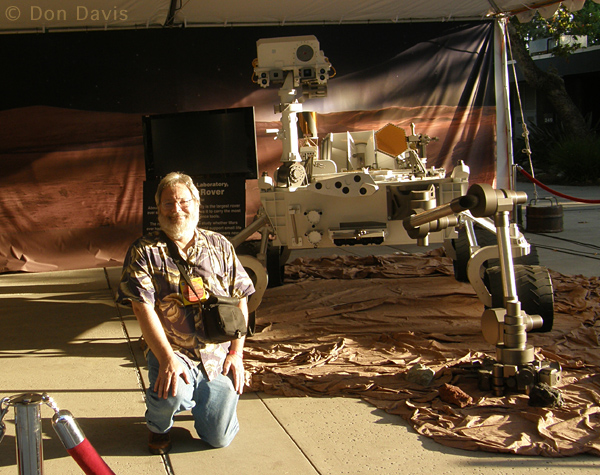
I waited until the Sun angle allowed most of
the fairly high fidelity rover model to be most evenly lit. At
one point an obliging reporter took a photo of me next to the
replica. Later while walking about I ran into one of the Rover
controllers, Nagin Cox. She knew who I was, and we briefly discussed
art and science. When I asked how long after landing it would
likely be until we saw images she said thumbnails should be down
within minutes, unless we had to wait for the next Odyssey orbit
some 90 minutes later.
Sunday, August 5, was a long eventful, tense
and joyous day. I arrived at Planetfest 45 minutes after opening.
I brought a range of acrylic paints needed to do a quick quadrant
painting of a Martian landscape with MSL about to land in the
distance. Jon Ramer prepared a board with a general format guideline
sketched in with soft pencil lines, which also demarcated our
quadrants to paint. I did the lower right, in between talking
to people managing to paint in 90 minutes a reasonably coherent
rough of rocks, dunes, talus slopes and textured terrain receding
into the distance. With the paints I left, Jon, Rick and some
locally recruited talent filled in the rest.
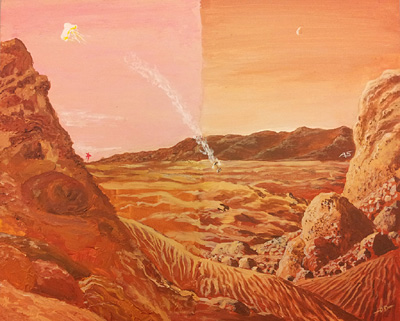
(right) The finished work. I painted the lower right quadrant
in about 90 minutes at Planetfest. Then Aldo Spadoni did the upper
right, followed by Jon Ramer at upper left, and finally a group
effort recruiting young artistically inclined Planetfest attendees
under Jon's guideance at the lower left.
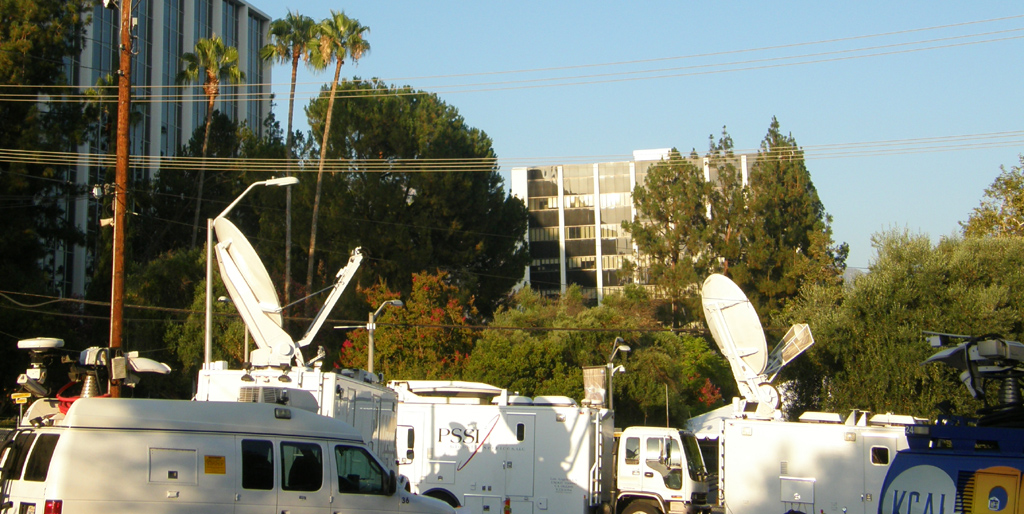
I left a little after five PM to get to JPL,
the warning having been given to arrive before 6:30. There was
no backup, the main media lot was full but there was plenty of
room in the outer lots stretching to the Northwest, lined by mature
oak trees. Walking across the lot, the towers of the satellite
trucks had sprouted overnight like tall mushrooms. Generators
roared, glimpses of mobile TV broadcast booths could be had in
open doors. Looming over it all was the building that controlled
the mission.
Inside the JPL campus were crowds of media, roving groups of VIPs
and hangers on, and occasional personnel directly involved with
the mission. Extensive effort had obviously been made to organize
the tasks to accommodate efficiently hundreds of people. The Curiosity
Rover and the models in the courtyard under the shade structure
were crowded with cameras and associated electronics and power
boxes, cared for and prepared for live and taped interviews broadcasting
all over. People from across the world were gathered there, groups
conversing in this language and that as one walked across the
campus within the limits for media clearly demarcated by signs.
I wandered as far West as possible to take a look at Mars in the
evening sky. I came upon rows and groups of people pointing up
and there was the brilliant ISS making a pass overhead! I then
walked East enough to see the bright triangle of Spica, accompanied
by the planets Saturn and on the right Mars, both worlds having
spacecraft around them spawned from and communicated with from
here, in the building where there is no day or night. Mars was
above a light and one had to look between trees but there it was,
a place we would soon see a new landscape of.
PAGE 2



